











Seahorse breeding programme
Seahorses are under threat worldwide. The world demand for seahorses and seahorse related products is vast with over 77 nations trading 25 million seahorses each year. There are over 35 species of seahorse with new species being discovered every year, with 5 new species of Pygmy seahorse discovered in 2009 in the coral reefs of the Red Sea and Indonesia. Research into the biology and vulnerability of seahorses was started back in the 1980s by Dr Amanda Vincent, who formed the conservation charity Project Seahorse. It is down to the commitment of the Project Seahorse team that seahorses are listed on the IUCN list of threatened species.
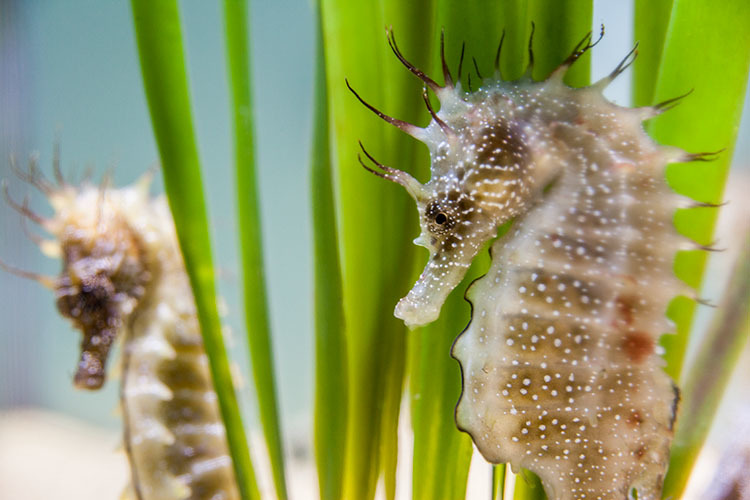
Preventing the demise of these beautiful creatures
Threats
Currently, the seahorses’ largest threat is their use in traditional Chinese medicines. Dead seahorses are ground up and used as cures or remedies for skin ailments, high cholesterol, excess throat phlegm, goiters, heart disease, lymph node disorders, incontinence, and impotence. As they keep their shape when dried many more are sold as souvenirs. The largest markets for these products are North America, Europe, Japan, and Taiwan. Despite being notoriously difficult to keep in home aquaria, thousands of seahorses are also taken each year for the aquarium trade, resulting in huge numbers dying quickly from poor nutrition, stress, and disease.
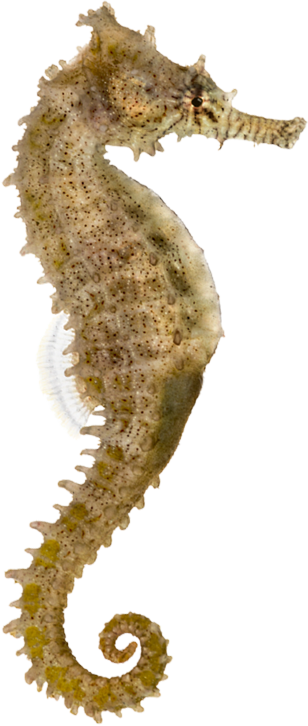
In conjunction with other aquaria in the UK and Europe, Anglesey Sea Zoo is committed to advancing the conservation of seahorses through education and research. The collaboration between public aquaria, conservation societies and universities provides a forum to share information on the management of seahorse populations in captivity, including successes and failures. It also gives us a stronger united voice to change current conservation policy and international legislation.
Our aims are to improve our husbandry techniques and share knowledge gained with others, and to increase awareness of seahorses through our education programme and graphics panels. We also aim to successfully breed native seahorses, learn more about their biology, and produce husbandry manuals for other organizations.
Our seahorse exhibit
We are one the only places in the world to have successfully bred the UK native Hippocampus hippocampus in captivity. In 2015, funding was confirmed from European Fisheries Fund and the Welsh Government for the construction of a new seahorse exhibit with both British seahorse species, Hippocampus hippocampus (Short-snouted seahorse) and Hippocampus guttulatus (Long-snouted seahorse)! This exhibit opened for the 2016 season.
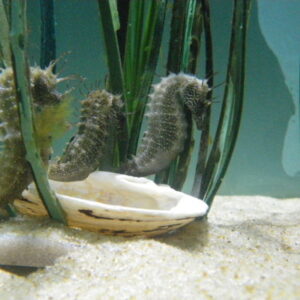
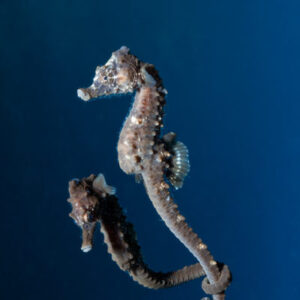
Seahorse biology
With the head of a horse, the tail of a monkey, the body of an armadillo, and the eyes of a chameleon, seahorses are one of the most bizarre fish you are likely to come across. Early zoologists initially classified seahorses as insects, and not fish, giving them all the generic name Hippocampus (derived from the Greek ‘ hippos ‘ meaning horse and ‘ campus ‘ meaning sea-monster). They are grouped into the family Syngnathidae, which also includes pipefish and sea dragons.
Body
Seahorses have few predators due to their bony bodies, over which their scale-less skin is stretched. Being slow swimmers they rely on camouflage to avoid predators and have the ability to change colour to blend in with their surroundings. Many also have the ability to grow long skin filaments to which seaweed and algae can attach giving the seahorse even better camouflage.
Beating as fast as humming bird’s wing, the small dorsal fin which is located half way down the seahorses back is its only method of movement. This makes them slow swimmers. They swim in an upright posture using their pectoral fins, found behind their head, for stabilising and steering. Male seahorses stay within small home ranges of 1m² with females moving within 100m², around their male partners.
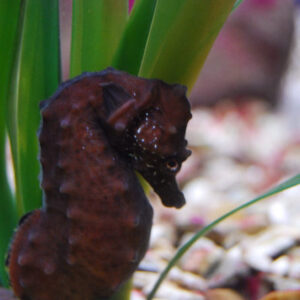
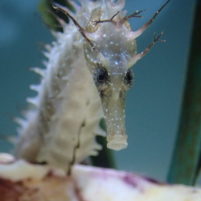
Species
Seahorses range in size from 16mm Pygmy seahorse (Hippocampus denise) up to the largest seahorse, the Pot-bellied seahorse (Hippocampus abdominalis) which can reach 35cm in length. They are distributed globally in both tropical and temperate marine waters, but are found nowhere in vast numbers. They live among seagrasses, mangroves and corals, and most species occur in the West Atlantic or the Indo-Pacific region.
Believe it or not, there are two species of seahorse found around the coastline of the British Isles: the Short-snouted seahorse (Hippocampus hippocampus) and the Long-snouted seahorse (Hippocampus guttulatus). The Long-snouted seahorse can be found living all the way up the west coast to North Wales whereas the smaller Short-snouted seahorse is found on the east coast. Both species tend only to be seen in our waters during the warmer months, migrating south to the Mediterranean during the winter. Sightings are rare due to the seahorse’s slow movement and fantastic camouflage amongst eelgrass beds so divers often miss them. Any sightings in British waters should be reported to the Seahorse Trust, who are collating information regarding the distribution of native seahorses.
Diet
Seahorses’ eyes are able to move independently looking out for food and predators at the same time. They are ambush predators, lying in wait for small fish and shrimps to come within range. They suck food in through their trumpet-like snouts and swallow it whole as they have no teeth.
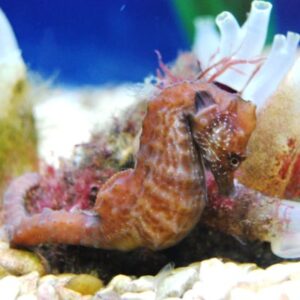
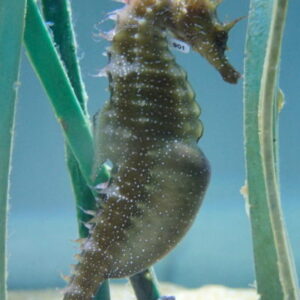
Reproduction
Paternal care of the young is common in fish (sticklebacks provide a well-known example) but whereas most male fishes only guard and fan the eggs whilst they develop, pipefish have taken this a stage further where the eggs are ‘glued’ onto the body of the male. Seahorses exhibit paternal care in its most extreme form. They possess a special enclosed brood pouch into which the female deposits her eggs and the male then fertilises them. Incubation can take between 10 days and 6 weeks depending on species and they can give birth to between 50 and 1500 babies each pregnancy. Male seahorses are often pregnant for as many as 7 months in the year!


